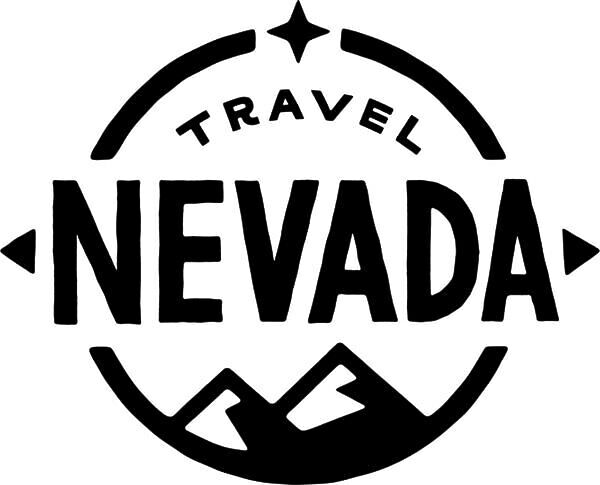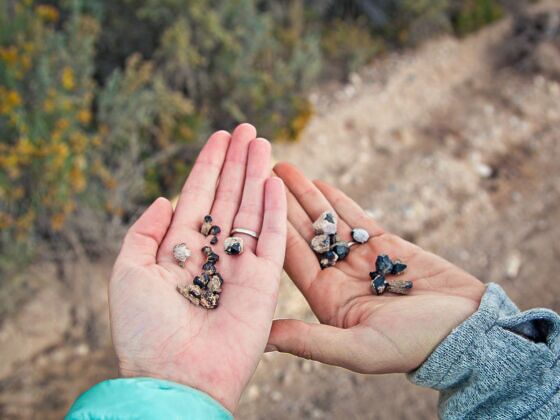Rockhounding in Nevada: Everything You Need to Know
We’ll admit it: rockhounding — collecting and digging for rocks, gems, and fossils — is a pretty niche hobby. But in Nevada, spending the day searching for little bits of natural history can be the perfect way to connect with the great outdoors. As you excavate, you’ll hear the pattering footsteps of lizards and smell the herbal aroma of sagebrush. Plus, the thrill of cracking open a slab of shale to reveal a trilobite fossil or unearthing a gorgeous nugget of turquoise is infectious. Once you find your first gemstone, you’ll wonder why you didn’t start rockhounding earlier.
Nevada contains more than 48 million acres of public land, and although you can’t rockhound on all of it, there sure is a lot to explore. You could also learn to rockhound at one of the dozens of pay-to-dig sites around the state — it’s called the Silver State, remember. Here’s how (and where!) to get in on Nevada’s many buried treasures, whether you’re a rookie rockhound or a tried-and-true veteran.

ON THE HUNT: WHERE TO GO GET STARTED: HOW TO BE A ROCKHOUND
Virgin Valley (Denio, Northern Nevada). Black fire opal, a dazzling gem that contains a rainbow of colors against a dark background, is only found in a few locations in the world — and Nevada’s Virgin Valley is one of them. Choose a pay-to-dig site (we recommend Rainbow Ridge, Royal Peacock, or Bonanza opal mines) for your chance to unearth one of these rare beauties.
Red Rock Canyon NCA (Las Vegas area, Southern Nevada). It’s all in the name — hike the 2.5-mile Fossil Canyon/Fossil Trail loop, and you’ll be walking amongst an ancient sea of sponges, shells, corals, and crinoids. The general rule of thumb for BLM land is that it’s illegal to collect vertebrate fossils without a permit but perfectly fine to seek out invertebrate fossils like these — however, Red Rock is a special designation with special rules, so your best bet here is to keep your camera handy and limit your collecting to photographs.
Black Rock Desert (Gerlach, Northwestern Nevada). The mysteries of the Black Rock Desert go well beyond Burning Man: With a 4WD vehicle, hit the eastern slopes of the South Black Rock Range, just northwest of Sulphur, to scout for geodes off old mining roads. A bit further west is the Calico Mountains Wilderness, where petrified wood deposits can be found in the aptly named Petrified Canyon. (You’re clear to rockhound up to 25 pounds of petrified wood per day, too, so long as you don’t disturb any surfaces or use any machinery within the wilderness boundary.)
Oak Springs Trilobite Area (Caliente, Southeastern Nevada). Millions of years ago, tiny, prehistoric trilobites (picture a dime-sized horseshoe crab) were perfectly preserved in the silty sediment of the Great Basin. Today, Oak Springs Trilobite Area holds these fossils in droves, if you know how to look. You won’t find many amenities here, so bring what you need for the day, but you’re free to keep any trilobites you find.
Garnet Hill (Ely, Eastern Nevada). Garnet Hill is a BLM recreation area, and there aren’t any pay-to-dig mines here — instead, this is a free-to-take site (yep, free gems!). It’s a great entry-level location because you can often find dark red spessartine garnets simply by grooming the ground. The area is also rich in volcanic rhyolite. With four picnic areas with grills, it’s a great place for the entire family to spend the day.
Otteson Brothers Turquoise Mine (Tonopah, Central Nevada). If turquoise is what you’re after, head to the most popular destination in the state for the gemstone: the Otteson Brothers Turquoise Mine in Tonopah. Sort through turquoise in every shade of blue-green until you find the perfect hue for you. Visitors can take home up to a bag of turquoise. Just be sure to make a reservation in advance — this spot is popular for its world-class colors. Half-day rates start at $150, while a full day will run you $300 per person.
Gemfield (Goldfield, Central Nevada). Chalcedony, agate, jasper, gold, silver — the mineral diversity of the aptly named Gemfield site is unrivaled. This one’s ideal for a more experienced adventurer looking for a remote experience amidst the sagebrush steppe. You’ll need a high-clearance vehicle and some wilderness know-how — there are no services (including public restrooms) in the immediate vicinity. Bring dollar bills, as it’s $1 per pound whatever you take, cash only via the honor system.
Berlin-Ichthyosaur State Park (Austin, Central Nevada). Preserving the country’s largest concentration of ichthyosaur (a giant fish-like dino) fossils and one ghost town, this state park is unlike any other. And while it’s against the rules to rockhound in the park itself, consider it your fossil-hunting basecamp. If you’re up for adventure, scope out nearby rock-cuts and old mines and see if you strike it lucky.
Wait, why is Nevada so great for rockhounds? In short, the state has a deep and varied geologic history that has allowed for the formation of both fossils and gemstones — the best of both worlds. Visit Las Vegas’s Springs Reserve, which includes the Nevada State Museum, for a deep, hands-on geologic dive, from greeting Nevada’s state fossil, the ichthyosaur, to stepping inside a stalactite cave.
What gear do I need? In Nevada, DIY means “dig-it-yourself.” Rockhounding is a great beginner activity because you don’t need much to get started. In fact, if you opt for a pay-to-dig operation, you can rent everything you need onsite. However, if you’re venturing out on your own, here are the basics to pack in with you:
- A rockhammer to help break up large rocks
- A bucket to transport your treasures so you can take them home
- Protective footwear with good traction for all that rocky terrain
- Safety equipment, like work gloves to protect your hands and safety glasses to keep rock particles out of your eyes
- Sun protection, including sunscreen, a sun hat, and a sun shirt, all essentials under the hot desert sun
- Plenty of water…goes without saying for any outdoor fun in Nevada!
When you’re ready to take your rockhounding to the next level, you may want to consider some additional gear:
- Hand tools, like a chisel or screwdriver, to break down rocks with more accuracy
- A spray bottle to expose hidden patterns and textures in rocks
- A brush to dust off your specimens
- A magnifying glass to be extra precise
- A kneeling pad to keep you comfortable
- Garden tools, like a shovel or rake
How do I prepare? Many pay-to-dig sites offer half- and full-day rates so you can search for gems at their mines. They often have rental gear and offer safety instructions and hunting tips to make the most of your experience. However, some sites, like the Otteson Brothers Turquoise mine in Tonopah, require that you bring your own tools. Check with the mine ahead of time so you know what to expect.
Rockhounding on public lands, rather than at a commercial site, is a rewarding experience. You can escape the crowds and experience solitude in the outdoors while finding unique specimens. But it does require a bit more patience and know-how. Be prepared for quick weather changes, navigating rocky terrain, and encounters with prickly plants or poisonous animals.
No matter where you hunt, pack for a long day in arid conditions. Bring plenty of water, snacks, and sun protection, and always leave no trace.
FINDING TREASURE: TIPS AND TRICKS
Know what you’re looking for. If you want the best chance of bringing home some serious treasure, brush up on your geology. You’re probably looking for something specific — a quick Google search can provide enough info so that you’re familiar with the specimen’s appearance and how it arises. For example, fossils are almost exclusively found in sedimentary rock, like sandstone, because it’s formed through a long, slow process without the heat and pressure that would destroy a fossil. When you’re hunting for a trilobite, for instance, you shouldn’t be wandering volcanic terrain.
Know where to look, too. Different sites and searches require totally different tactics. Do you need to dig into the earth to find geodes, crack open shale to reveal a fossil, or rake the ground to turn up garnet crystals? For a spot to practice training your eye, visit Tule Springs Fossil Beds National Monument. While it’s illegal to take specimens from here, the ground is littered with fossils near the surface — if you bother to look! (Tip: Connect with the Protectors of Tule Springs for a guided tour.)
Know how to use your tools. When it comes to wielding your rockhounding tools, use them wisely. The number one rule? Don’t go too hard. You’ll employ the rockhammer to crack open rocks, not smash them to smithereens. Then, if and when you find a gemstone, you can use hand tools to delicately extract it. Lastly, whip out the spray bottle or brush to remove dust, clean off the crystals, or illuminate subtle markings in your specimen.
Show off your Nevada treasure. Once you’ve nabbed your bounty, enjoy it! Many visitors make their finds into one-of-a-kind jewelry or display them at home. However you choose to show off your Nevada souvenirs, you should clean them first by soaking them in soapy water and using a toothbrush to get rid of any remaining dirt. The result can be a real showpiece. How’s that for hitting the jackpot?

